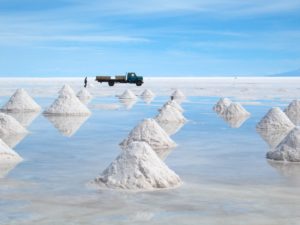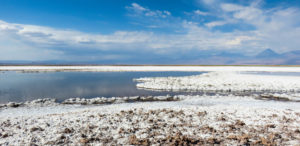The activity of Chinese companies in Argentina, which has grown significantly in the last decade, has taken on a new dynamism in the mining sector. While Shandong has bought 50% of the huge Veladero gold mining operation owned by Canada’s Barrick Gold – a company that oversaw more than three spills in just under a year and a half, there is a special interest in lithium mining.
Lithium is a key element in batteries used in electrical appliances such as mobile phones and laptops, and electric vehicles. New uses for lithium mean demand has boosted significantly over the last decade, particularly in Asia, where these products are manufactured.
China has become the number one consumer of lithium in the world, accounting for 35% of total consumption
Yet mining has of late been a subject of intense debate in Argentina owing to accidents and its intensive use of energy and scarce water resources. As a comparatively new and booming global industry, the environmental impacts of the various methods of lithium extraction are not yet sufficiently understood.
Today, China has become the number one consumer of lithium in the world, accounting for 35% of total consumption, followed by Europe (24%), Japan (11%), South Korea (10%) and North America (9%). At 56%, Asia accounts for more than half of the world’s consumption. China’s demand has doubled in the last decade, rising from 18,000 tonnes of lithium carbonate equivalent (LCE) in 2002, to 50,000 tonnes in 2012.
Urgent social and environmental impacts
Lithium mining is presented by its main promoters as having lesser environmental impacts than open-pit mining. But it is not an innocuous practice. It generates a different set of environmental impacts that are not being properly addressed.
The technology used to separate lithium compounds (carbonates, sulphates) from other chemical elements depends on various factors unique to each salt flat: The concentration of lithium and potassium; the ratio between lithium and magnesium; and evaporation and precipitation rates.
In Argentina, lithium extraction is a particular concern due to the delicate balance of water systems of the Puna region, where fresh water also feeds into plains and lagoons, and where local communities depend on it.
The salt flats of the Puna region are found in what’s known as an endorheic (or closed drain) basin, which have no outflowing rivers and is considered a fragile ecosystem owing to the water stress it experiences throughout the year. However, in most cases, projects are approved without sufficient information or background studies on the delicate functioning of these ecosystems. In particular, no comprehensive hydrogeological studies of the basin have been conducted to determine the significance and type of impact.
Nor are the social demands and concerns of various groups of indigenous communities living in the Puna territories taken into account. While some proclaim the economic benefits of mining, others oppose it on the basis of its impact on the supply of water. Opponents also decry a lack of respect for participation and consultation in the decision-making process, which is enshrined in Argentinian law.
In light of this insufficient grasp of the environmental aspects and social consequences linked to lithium, the huge growth of the market and arrival of entities, among them Chinese, is a concern.
New players
Chinese companies such as Sinopoly Battery Limited, are among the top five players in the lithium market, with a 5.42% share. The arrival of Chinese capital in the country, while more recent, is not surprising, given new rules in Argentina on foreign involvement in the mining sector.
Argentina is part of the Southern cone lithium triangle, an area containing 60% of the world’s lithium brine deposits, whose other points lie in Bolivia and Chile. These three countries are the only ones in which lithium can be freely exploited by way of concessions granted by relevant authorities. Extracting lithium from brine by evaporating a solution containing the mineral in an open-air pool, as is mostly the practice in these countries, is currently form of extraction with the lowest costs.
Chinese interest in lithium is not limited to this case, with projects in the north-western Argentine province of Catamarca also highly coveted
Argentina’s neighbour Bolivia initially set aside the famous Salar de Uyuni salt flat as a tax reserve, forbidding the granting of mining rights. This came after deciding to carry out predominantly state-led lithium exploitation, with little private sector participation. Due to its limitations, the Bolivian government reviewed this strategy, opening the way for Chinese and South Korean capital investment.
Chile has granted no lithium concessions since 1979, when the military government considered the resource strategic due to its use in nuclear technology. This enabled Chile to develop the industry more than its neighbours. At present, discussions are underway regarding the relaxation of overseas involvement providing there is coordination with the state.
For Argentina, the presence of transnational companies in the mining sector is not new. However, the elimination of a mining withholding tax in February 2016 brought in new foreign investment. Announcements of lithium projects significantly increased, and the names of interested companies began to be known.
One of the first significant events in Argentina was Chinese company Ganfeng’s joint venture project with the Chemical and Mining Company of Chile (SQM) and the Canadian firm, Lithium Americas Corporation (LAC) for exploitation in the Salar de Olaroz-Caucharí, in the western province of Jujuy, some 70 kilometres from the Chilean border. Under the terms of the agreement, Ganfeng would acquire 19.9% of the shares of LAC, and provide US$125 million to cover construction costs. In doing so, Ganfeng would secure the purchase of 70% of lithium production during the first phase of production.
This case is notable for two reasons: first, because Ganfeng and SQM had tried to reach an agreement regarding operations in Chile without success; secondly, SQM has it’s own difficulties in expanding its operations in its native Chile, where it is beset by scandals linked to financing political parties.
In the area surrounding the Salar de Olaroz-Caucharí, Chinese finance will also be channelled into one of the largest solar parks in the world, which will have an installed capacity of 300 MW. This project will supply, not exclusively, nearby mining operations.
Chinese interest in lithium is not limited to this case, with projects in the north-western Argentine province of Catamarca also highly coveted.
Strong competition for lithium has led various conglomerates dominating the market to try and control the different stages of the value chain. By using “joint ventures” arrangement, lithium companies or mixed consortia join forces with public or mixed local companies, as well as the automotive sector, to expand their portfolios. This is how they achieve direct access to lithium mines and ensure a certain volume of the lithium carbonate or lithium chloride compound.








